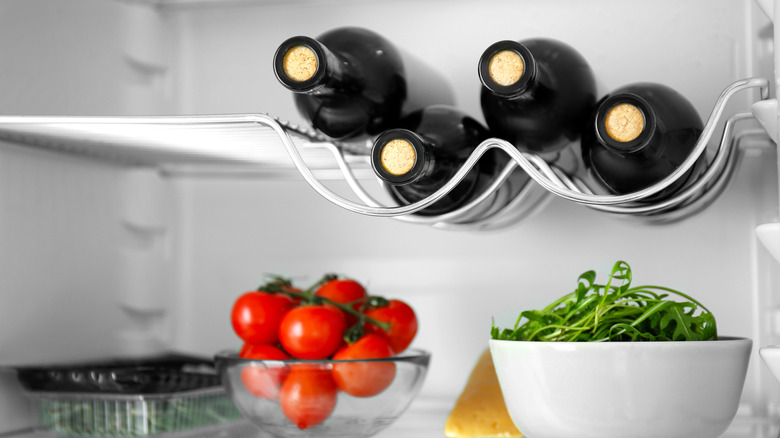Your Red Wine Needs To Be Colder Than You Think For Optimal Drinking
When it comes to wine, lots of people swear by the general rule of thumb of keeping refreshingly cold summer whites and rosés chilled versus deep reds, which are considered best kept at room temperature on the storage rack. While essentially correct (whites should generally be enjoyed colder than reds), the topic of what temperature and occasion to serve your wine is far more nuanced than many think.
For instance, a luxurious glass of red isn't reserved only for the chilly darkness of winter months. On the contrary, the balance of blackberry jam and spiced flavor notes in a good, medium-bodied malbec make it a perfect wine to enjoy at summer barbecues, according to chef Aarón Sánchez, alongside grilled steaks, veggie skewers, and lemony pasta salad.
To get the best flavor when pairing a variety of foods like braised lamb with red wine, however, your wine needs to be colder than you think. Storing reds at room temperature or warmer actually mutes the beautiful hints of cherry, raspberry, and fig in a glass of tempranillo. Instead, giving your red wine a slight chill brings out those fruity flavors, which is especially good in the summer (or any time of year, for that matter), making juicy reds even more drinkable. To fully showcase the succulently rich flavor of the beverage, especially those with light to medium-bodied taste, reds are best served slightly under room temperature, between 62 to 68 degrees Fahrenheit.
How to chill your red wine
When chilling red wine in advance of a night on the patio sipping with friends, it's important to note that the goal is not to serve it cold. Instead, focus on giving your wine only a slight chill to accentuate its palette.
To do so, you don't have to leave your bottle in the fridge all day — all it needs to chill is 15 minutes (or up to 30 minutes on a hot day) in the refrigerator before pouring some into glasses and toasting to a day well spent. You can also leave your wine outside for a few hours on a cool afternoon with ample shade if the temps are around 60 degrees Fahrenheit.
If you forget to chill your bottle before your guests arrive (we've all been there), simply fill a bucket with water and ice, and place your red in the ice bucket for 10 to 15 minutes before drinking it. Once it has chilled, on a cool evening, remove your bottle from the ice bucket and leave it on the table to avoid dropping the temperature too low (you don't want the wine to be ice cold).
In a pinch, you can chill red wine in the freezer for up to 10 minutes. And for true connoisseurs looking to make the investment, there are decanters that come with a separate ice compartment (yes, it's a thing).
Consider the body and flavor of your wine
When chilling your red wine, it helps to know some basics about the flavor profiles of different types. Generally, lowering the temperature to a slight chill brings out bursts of fruity and warm spiced flavor notes in younger light and medium-bodied reds, including pinot noir and cabernet franc.
However, chilling red wine is also known to mute the presence of tannins, the compounds produced from the bark in wood barrels used to age wine. Tannins can give full-bodied, aged varietals a bitter taste and astringent mouthfeel (similar to the mouth-drying effect of drinking black tea), which is ideal for deep, dry wines that pair well with rich cheesy pastas and fatty cuts of meat.
Fuller-bodied reds prized for their tannins, such as cabernet sauvignon and syrah, still benefit from a chill but should be chilled for less time to avoid totally dulling their tannin profile. Give fuller reds less time in the fridge or ice bucket, just enough to make sure the wine is not warm, which will help round out its flavor. If you're looking for a bottle where the tannins are less pronounced and easier to drink for a summer cookout, opt for light to medium-bodied reds with more juicy notes.


